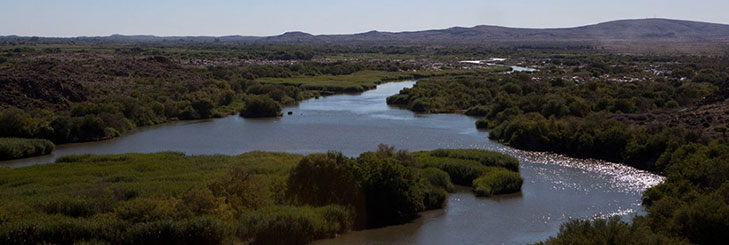Welcome to the first surface water quantity report of the Orange-Senqu River Commission (ORASECOM), for the hydrological year 2020-2021. For Read more
Categories
Latest Submission
2020-2021 Orange-Senqu Surface Water Quantity Synoptic Analysis
Khakea-Bray Transboundary Dolomite Aquifer Recharge Assessment
Documentation and Data: A read-only folder structure of all reports, data, and models related to the STAS can be accessed Read more
Improving Groundwater Knowledge in Selected Transboundary Aquifers
Documentation and Data: A read-only folder structure of all reports, data, and models related to this study can be accessed Read more
Stampriet Transboundary Aquifer System (STAS) – Governance of Groundwater Resources in Transboundary Aquifers (GGRETA) Project
Documentation: A read-only folder structure of all reports, data, and models related to the STAS can be accessed from here: Read more

- WIS > Biota and Ecosystems > Environmental Flow Requirements for the Orange-Senqu Basin (WP5)
Environmental Flow Requirements for the Orange-Senqu Basin (WP5)
- Author:Bennie Haasbroek
- Post date:27 January, 2014
- Categories:Biota and Ecosystems,Surface Water Resources
Objectives
The main objective for this Work Package is to assess Environmental Flow Requirements
(EFRs) at selected key areas of the Orange River Basin at an “Intermediate Level”.
Main Activities
The main activities included:
- A scoping level assessment of ecological and socio-cultural condition and importance across the basin.
- Delineation into Management Resource Units and selection of Environmental Flow Requirements sites.
- One biophysical survey to collate the relevant data at each Environmental Flow Requirements site.
- Measurements at a low and a high flow to calibrate the hydraulic model.
- Assessment of the Present Ecological State and other ecological state scenarios
- Assessment of flow requirements following a holistic approach, preferably those developed specifically for local and regional conditions for each ecological state.
- Assessment of the ecosystem services, also referred to as Goods and Services
- Monitoring aspects.
Conclusions
Environmental Flow Requirements
The detailed conclusions for each of the Environmental Flow requirements sites are provided in the reports below.
No environmental flow requirements were set at the first Environmental Flow Requirements site “EFR 1” (downstream of Vanderkloof Dam) as it was felt that there would be no scope in terms of adjusting flows. The ecological state was assessed and recommendations made that included non-flow related measures.
“EFR 8” situated in the Molopo wetlands downstream of the Molopo eye was also approached in a different manner. Setting flow requirements within such a modified system will serve no purpose. In order to improve the wetland the main objectives set for “EFR 8” were to revert back to a functioning wetland which can be achieved by:
- Improved Phragmites cover.
- Reinstatement of shallow areas with constant depth.
- Cease spraying of toxic pesticides for control of the Red-billed Quelea (Quelea quelea) and reeds.
Good and Services
The range of Goods and Services available at the lower end of the Orange River ensures that
these reaches are rendered more sensitive to management interventions. The converse is generally true for the upper sites. In addition, there are a body of users of Goods and Services in the lower part of the Orange for whom livelihood and linkage to these Goods and Services is of paramount importance. Conversely for the Caledon, particularly the upper site, in spite of a dependency on Goods and Services, the highly impacted state of the river means that management interventions will not result in substantial changes to the delivery of Goods and Services. In addition, in these areas the most important management interventions will not be flow-related and probably relate to a wider programme of catchment management. The Kraai River is in many respects in a good state, and the usage relatively low. As such, management interventions will not yield dramatic results. These were derived from modelling the results for each EFR site with the importance of each category of Goods and Services weighted. Those deemed to be most important at the site were given a weighting of 100. Those of marginal importance were given lesser weightings.
Recommendations
Based on the confidence evaluation of the results, recommendations were made where additional information is required to improve the confidence. These recommendations can be found in the reports below. A recommendation which is standard for all the Environmental Flow Requirements sites is to initiate an Ecological Water Resources Monitoring (EWRM) programme as this is essential to measure whether objectives are being achieved.
This would lead to a key strategic level actions that are required as part of a basin-wide plan
that should include the following:
- Testing of various operational scenarios that could include new developments or changes in the existing operation of the system. Testing of these scenarios must be done in terms of changes in ecological state and Goods and Services.
- These results should then be presented to the stakeholders so that agreement can be reached on the future ecological state of the river.
- An extensive and joint monitoring system should then be implemented. It is strongly recommended that an Ecological Water Resources Monitoring (EWRM) programme is initiated as soon as possible. The information gathered during this study is suitable for the baseline, but if too much time relapses between the baseline and monitoring, new surveys and Eco-Classification process will have to be undertaken. It must be noted that monitoring of essential Goods and Services should be included as part of the EWRM.
Source:
Support to Phase 2 of the ORASECOM Basin-wide Integrated Water Resources Management Plan
Funding Organisation(s):
Date:
2011
Documents
Huggins, G. et al. 2010. Assessment of Environmental Flow Requirements: Goods and services
Louw, D. et al. 2010. Assessment of Environmental Flow Requirements: Main Report Volume 1
Louw, D. et al. 2010. Assessment of Environmental Flow Requirements: Main Report Volume 2



Comments
You must be logged in to post a comment.